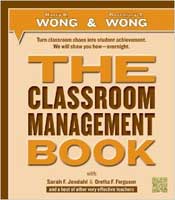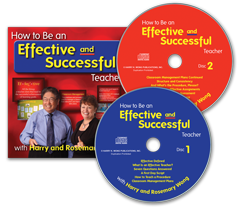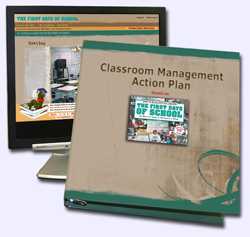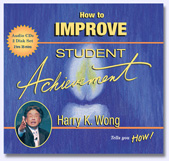|
 |

Special to the Gazette
August 2013
Planning, Planning, Planning
Planning creates a roadmap for your success. If you were fortunate, your college education courses prepared you for your journey and helped you create a Classroom Management Plan. But, more often than not, classroom management is not taught to preservice students despite the fact that it has been listed as the #1 factor that must be implemented for student achievement to take place. (Gordon Cawelti, ed., Handbook of Research on Improving Student Achievement, 2004) We recently presented at a university where the school officials told us that the #1 feedback from their graduating preservice teachers was the need for a course in classroom management, yet the university refuses to offer one. When we asked why, we were told classroom management was embedded in all of their courses. Yet, their students were asking for more. We suspect, the students were asking for clarity—for direction—in the what, whys, and how to for the basics of classroom management. Planning at Louisiana State University
Dr. Elecia Lathon teaches the classroom management class at Louisiana State University in Baton Rouge and Megan Toujouse was one of her students. Elecia uses an analogy and some of her mother’s wisdom to explain why her students need to take the stairs to their success.
Elecia gives her students many tools to use as they progress through the labs. Her templates and checklists include all of the components necessary to build out that particular section of a classroom management plan. Click each item to view.
Elecia’s student, Megan, says that the Classroom Management class was possibly the most important education class she took throughout her academic career. She says, “Dr. Lathon helped me create my Classroom Management Portfolio, something that I have used during my first two years of teaching more times that I can count. “The Classroom Management Portfolio had, of course, the procedures, but the most valuable components were the professional growth plan, self-assessment rubric, and philosophy of education. Each of the steps of the component stairs has become an integral part of my job as a classroom teacher.” When Megan started interviewing, she proudly brought her Classroom Management Portfolio and showed the interviewing principals and vice-principals her “blueprint” for teaching and classroom management. The principals all commented that the Classroom Management Portfolio showed her strength in organization. It was a good snapshot of who she was and what would be expected if she was to be hired.And there is no question as to why Megan was hired! When Megan was hired and started planning for her first year of teaching, she took her classroom management binder and started pulling out what she wanted to use for the upcoming school year. After taking what seemed like everything out but the dividers, she realized that Dr. Lathon was right. The binder contained everything she needed from a management perspective to be a successful teacher. Megan used the binder to script her first days of school and it made the beginning of the year a breeze. During the first two years of her teaching, she has been complimented by administrators, colleagues, and parents on her organization and professionalism. Megan says, “Though these are two skills that I will continue to grow in throughout my career as a teacher, I know the foundation of these came from my class with Dr. Lathon.” Megan succeeded in her first year of teaching and continues to be effective for her students. University of New Orleans
Lena prides herself on making sure that everything that her students do in class is something they can use in their classrooms. Thus, the students leave her course with a Classroom Management Plan (CMP) that they can immediately put into practice. The Classroom Management Plan is created throughout the semester course. An outline is provided and as each section is submitted, there is class discussion and feedback. The students then revise their work before putting the pages into their binders as a final product. These are some of the major sections included in each student’s CMP:
Her students are also required to create an Opening Day PowerPoint Presentation. They create this presentation throughout the semester, while they are working on their CMP. This allows them to double dip. As they get feedback on the pieces of their CMP, they simply create a corresponding slide for the PowerPoint presentation. This way, they will not have a huge project to complete at the end of the semester. Lena comments that her students are usually the ones with big smiles on their faces at the end of the semester, because some of their friends are stressed out over big, end-of-the-year projects while her students have completed all course requirements as they progress through the semester. The students’ hard work also benefits them as they enter the job market. She suggests that her students make copies of their Opening Day PowerPoint Presentation and leave it with the interviewer. The presentation is put on a disc with a professional-looking, computer generated label that includes a head shot to increase the chance that they will be remembered. Lena says that she gets numerous emails from students about bringing their CMP with them to interviews. Each one of these emails state variations of, “I got the job because of my CMP.” The principals who interview them say things like, “You did all of this?” and “You have really thought of everything!” She saw one of her former students at the market and he thanked her for having the class prepare a Classroom Management Plan in a binder, as the plan is what got him a job. She laughs because the students sometimes complain of the work during the semester, while they are creating all the pieces of their CMP, but when it is complete, at the end of the semester, they all feel a sense of pride, relief, and confidence with their Classroom Management Plan! William Penn University
Kathryn Roe teaches the Classroom Management class (EDUC 355) at William Penn University in Oskaloosa, Iowa. Because she has been a teacher and a principal, her advice to her students is very valuable. She tells them she has observed that many people believe the way to get students, children at home, workers in the adult world, or even people in general, to do things in a particular way is to threaten them with punishment. Because many preservice students have grown up in such a world, it is very difficult for them to envision teaching procedures without consequences and approaching things from a positive mindset.
With her principal’s support, she made those two changes successfully and that is what she teaches her students because she knows What Works. Kathryn brings her years of experience to her course as she guides her students through the creation of a Comprehensive Classroom Management Plan (CCMP). “Comprehensive” is the best way to describe how well she prepares her students for the teaching world. Click here to see The Comprehensive Classroom Management Plan that is the assignment for her class. Kathryn has very valuable advice for preservice students going out to look for a job. She tells the students in her Classroom Management class that most job interviews last 30 to 45 minutes. Because the face-to-face time with the interview team is limited, she recommends that they take the CCMP to the interview and offer to pass it around, but to be mostly prepared to use it to illustrate answers to some of those standard questions asked during an interview.
Kathryn demonstrates how to have the CCMP prepared in such a way that they can easily flip to the section that applies to the question. Doing this shows the interview team that the candidate has thought about this ahead of time and knows it is important. The CCMP will also help the candidate jog his/her memory about that particular topic so the candidate can make a more considered response. Kipp Schuler is one of her former students. He took his Comprehensive Classroom Management Plan with him to his interview. He got the job and is now a high school science teacher. Know Your Plan When Kathy Vohland, a principal in Washington, interviews prospective new teachers, she always asks, “What is your classroom management plan?” She says that 99 percent answer with their discipline plan. One percent answers with their procedures. “That’s the one I hire,” she says. It is never too late to set the course for a successful journey. We are in a profession where each day can be a new beginning, each year a fresh start. Today is the day for you to start anew.
Spend these last days of summer planning—planning for your success and your students’ success. Even the most effective teachers keep planning year after year. They know that the stairway is the sure path to success. Success lies in the journey and the lessons learned along the way—not in taking the express elevator to the top and skipping the opportunity for growth, achievement, and renewal. If you are a preservice teacher, still interviewing, develop a Classroom Management Plan and take it with you to interviews. Your planning now will be realized when you become the leader of your classroom. If you are a veteran teacher and counting the days until you return to the classroom, spend some time in reflection of what worked, what didn’t work, and what you can do to bring excitement to your classroom this school year. Children will be running to your classrooms in search of the stability you have built and the learning you offer to them. Feel confident in knowing that you are ready to face the challenges and joys of the school year because you have a plan. And now, just do it. Activate your plan for a successful and effective 2013-2014 school year.
|
|||||||||||||||
|











